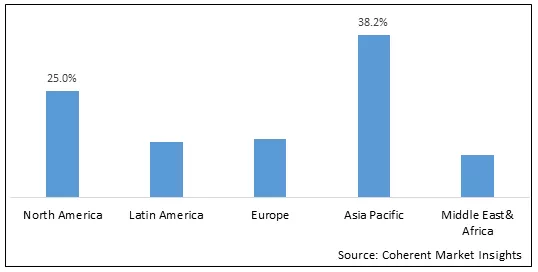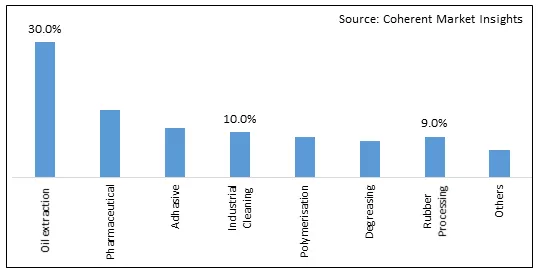The N-Hexane Market size is valued at US$ 2.7 Bn in 2024 and is expected to reach US$ 3.5 Bn by 2031, growing at a compound annual growth rate (CAGR) of 3.8% from 2024 to 2031.
N-Hexane Market Regional Insights:
Figure 1. N-Hexane Market Share (%), By Region, 2024

To learn more about this report, request a free sample copy
N-Hexane Market- Analyst’s Views:
The n-hexane market is expected witness steady growth driven by the increased demand from industries such as manufacturing of solvents, adhesives, and pharmaceuticals. The Asia Pacific region dominated the global n-hexane market share in 2021 owing to growth in industries requiring n-hexane as a solvent in countries like China and India. Stringent regulations around the use of n-hexane due to its flammable nature pose a potential restraint to the market. The market is also restrained by availability of substitutes like heptane and other hydrocarbon solvents. Opportunity lies in developing nations with growing manufacturing sectors requiring n-hexane for uses like extracting edible oils. Growth of end-use industries and rising per capita consumption in developing regions will drive demand. Recovery of global economy post pandemic will further spur industrial demand.
Usage of n-hexane as an extracting agent for edible oils is a major growth driver. The expanding pharmaceutical industry where n-hexane finds application as an excipient in tablets and capsules offers potential opportunities. In developing nations, the consumer demand for cosmetics and personal care products where n-hexane has usage as a solvent also supports the market growth. Recovery and increasing trend of insourcing production in North America and Europe also presents growth prospects.
N-Hexane Market Drivers:
Used as solvent in industrial cleaning and degreasing applications: N-Hexane is increasingly being used as an effective solvent in industrial cleaning and degreasing processes across many industries. Its low cost and evaporation properties make it suitable for removing oils, greases, dirt, and other impurities from metal parts during manufacturing. As global industrial production continues to rise in the coming years to meet post-pandemic demand, the use of n-hexane as a cleaning agent is expected to see parallel growth. N-hexane providers are actively promoting its cleaning capabilities. Major players have successfully demonstrated to key industries how using n-hexane can help achieve superior degreasing performance compared to alternatives, thereby improving production efficiency. For instance, according to the World Bank data, industrial production increased by 3.8% in 2021 from 2020.
Growing consumption in adhesive production: The use of adhesives in various end-use industries has seen tremendous growth in the past few years. Adhesives are increasingly being used for bonding different types of materials together in applications ranging from construction to automotive sector. N-hexane plays a crucial role as a key ingredient in the production of many adhesives that are popularly used across different industries.
The higher consumption of adhesives driven by increased infrastructure development and automotive production has led to a rise in the demand for N-hexane as well. Construction activities worldwide have picked up pace after slowing down during the pandemic. Many countries are undertaking large public infrastructure projects such as bridges, roads, rail networks, etc. to boost economic recovery. This has augmented the use of adhesives for applications like gluing beams together, flooring, etc., thereby raising the requirement for N-hexane in adhesive production.
The global automotive industry is also witnessing healthy growth prospects with rising vehicle ownership even in developing nations. Adhesives find widespread application in vehicle manufacturing for tasks like assembly of vehicle parts, bonding of exterior body panels and many other purposes. For instance, as per the International Organization of Motor Vehicle Manufacturers and other sources indicate that global motor vehicle production is expected to grow at a compound annual growth rate (CAGR) of around 1.1% from 2021 to 2026, reaching over 104-105 million units in 2026.
N-Hexane Market Opportunities:
Focus on developing bio-based and eco-friendly hexane products: The demand for more sustainable and environment-friendly products has been steadily increasing across many industries. The N-hexane market is well positioned to capitalize on this trend by innovating new bio-based and eco-friendly hexane products. Hexane is widely used as an extraction solvent for edible oils from plants and seeds. However, traditional hexane is produced from petroleum sources and poses hazards to human health and the environment if not handled properly. Developing bio-based hexane extracts sourced from renewable feedstock such as agricultural waste could provide a greener alternative for the food industry that aligns with consumers growing demand for sustainable options.
Investing in R&D to create bio-based hexane products extracted from crops already in production would allow hexane manufacturers to tap into existing biomass resources. For instance, according to the U.S. Department of Agriculture (USDA), U.S. farmers produce over 700 million tons of corn stover and wheat straw annually, but only a small fraction of these feedstock is currently utilized.
Potential in emerging economies owing to industrialization: Emerging economies across Asia pacific , Africa, and Latin America are expected to see significant industrialization and infrastructure development over the next decade. Countries like India, Bangladesh, Indonesia, Egypt, Vietnam, and others are making large investments and policy pushes to boost their manufacturing sectors.
As industrial activities proliferate across sectors in the developing world, the need for specialized chemicals in various manufacturing processes will also increase rapidly. N-hexane extracts are extensively used as thinners in the paints, coatings, and inks industries. With more factories, plants and construction sites coming up, consumption of these end-use products and thereby N-hexane extracts is projected to have strong growth trajectories over the medium term. Countries like India have launched ambitious programs to boost domestic manufacturing like 'Make in India'. Successful implementation of these state-led initiatives will pull massive investments in setting up new production facilities for diverse industries over the coming years. This is likely to create sustained demand drivers for industrial intermediaries and inputs like N-hexane in these emerging markets. For instance, according to the Indian government data, India aims to raise the manufacturing sector's contribution to 25% of the GDP by 2025 from the current 15-16% through initiatives like the Make in India program and production linked incentives.
N-Hexane Market Report Coverage
| Report Coverage | Details | ||
|---|---|---|---|
| Base Year: | 2023 | Market Size in 2024: | US$ 2.7 Bn |
| Historical Data for: | 2019 to 2023 | Forecast Period: | 2024 - 2031 |
| Forecast Period 2024 to 2031 CAGR: | 3.8% | 2031 Value Projection: | US$ 3.5 Bn |
| Geographies covered: |
|
||
| Segments covered: |
|
||
| Companies covered: |
ExxonMobil Corporation, Royal Dutch Shell PLC, Indian Oil Corp. Ltd., Chevron, Phillips Chemical Company LLC, Bharat Petroleum Corp. Ltd., Rompetrol Rafinare S.A., Hindustan Petroleum Corporation Limited, Dongying Liangxin petrochemical company, Liaoning Yufeng Chemical Co., Ltd., DHC Solvent Chemie GmbH, and Sak Chaisidhi Company Limited |
||
| Growth Drivers: |
|
||
| Restraints & Challenges: |
|
||
N-Hexane Market Trends:
N-Hexane Market Restraints:
Availability of substitutes like sodium hydroxide and isopropyl alcohol: The availability of substitutes for N-hexane such as sodium hydroxide and isopropyl alcohol poses significant challenges for the growth of the N-hexane market. Sodium hydroxide and isopropyl alcohol can replace N-hexane in various industrial applications which currently utilize N-hexane. Sodium hydroxide is commonly used as an alternative in industries such as pharmaceuticals, chemicals and agriculture for processes involving extraction and separation. It serves as an effective alkali reagent and provides comparable results to N-hexane with the advantage of being less volatile and hazardous. Similarly, isopropyl alcohol is substituting N-hexane in cleaning agents and solvents owing to its enhanced solvency power and rapid evaporation capabilities. Various industries are inclining towards sodium hydroxide and isopropyl alcohol to fulfill their extraction and purification needs due to stringent health and safety regulations pertaining to N-hexane. For instance, as per data published by the American Chemistry Council in 2021, nearly 50% of pharmaceutical manufacturers in the U.S. have already replaced N-hexane with sodium hydroxide and isopropyl alcohol in their production processes over the last five years, citing toxicity issues of N-hexane.
Counter balance: Tailor solutions to meet the individual needs of customers, including providing technical support to demonstrate how N-hexane can be used effectively and safely, enhancing customer satisfaction and loyalty.
Health hazards associated with n-hexane: Health hazards associated with n-hexane is significantly restraining the growth of the N-hexane market. N-hexane is a highly volatile organic compound and prolonged exposure to it can cause adverse health issues in human beings. N-hexane is known to damage the peripheral nerves system and its prolonged exposure leads to polyneuropathy otherwise called as hexacarbon neuropathy, which results in numbness and weakness in legs and arms.
The health effects of n-hexane vary depending on the level and duration of exposure. Short-term exposure to very high concentrations of n-hexane can cause headaches, nausea, and dizziness. At very high concentrations, it can cause loss of coordination, weakness, irritation of the eyes, and respiratory system. Reports from the World Health Organization (WHO) suggest that exposure to high concentrations of n-hexane over longer periods can damage the peripheral nerves and nerves termed as polyneuropathy. It may also cause long-term numbness in the hands and feet. For instance, WHO published report in 2020, regular exposure to n-hexane concentrations above 100ppm can cause a slowing of nerve conduction in the majority of workers within a few years. The report analyzed workplace health studies conducted across industries in India, Thailand, and other Asian countries where n-hexane exposure standards are not strictly enforced. It found that over 60% of workers exposed to 150-300 ppm of n-hexane for 3-5 years demonstrated signs of peripheral neuropathy including the loss of muscle strength.
Counter balance: Conduct regular training for employees regarding the safe handling of n-hexane, emphasizing the importance of personal protective equipment (PPE), exposure limits, and emergency procedures.
Recent Developments:
Acquisitions and partnerships :
In February 2021, GFS Chemicals, Inc. announced its new partnership with Hanna Instruments USA, Inc. With this approach, GFS expanded its customer base by product offerings that include Karl Fischer titration solutions and other specialty solvents and reagents for applications like peroxide value, acid number, and more.
GFS Chemicals, Inc., formerly known as G. Frederick Smith Chemical Company, is a privately owned fine and specialty chemical company with headquarters in Powell, Ohio and manufacturing facilities in Columbus, Ohio. It was founded by G. Frederick Smith in Urbana, Illinois in 1924, and moved to Columbus, Ohio in 1928. GFS Chemicals currently serves over seventy countries and a variety of industries, including: Alternative energy, energy storage, pharmaceuticals, biotechnology, electronics, etching, and more. The company offers a wide range of fine and specialty chemicals, including analytical reagents, organic chemicals, and inorganic chemicals. GFS Chemicals is known for its expertise in the manufacture of perchloric acid, alkyne building blocks, and Karl Fischer reagents.
Figure 2. N-Hexane Market Share (%), By Application, 2024

To learn more about this report, request a free sample copy
Top Companies in the Space Medicine Market:
Definition: N-hexane is an organic compound and a straight-chain alkane with six carbon atoms, having the molecular formula C6H14. It is a colorless liquid with a petroleum-like odor, less dense than water, and insoluble in water. Its boiling point is approximately 69 °C (156 °F). N-hexane is widely used as a cheap, relatively safe, largely unreactive, and easily evaporated non-polar solvent, and modern gasoline blends contain about 3% hexane. It is also used as a denaturant for alcohol, cleaning agents in the textile, furniture, and leather industries, and in the printing industry.
Frequently Asked Questions
Joining thousands of companies around the world committed to making the Excellent Business Solutions.
View All Our Clients